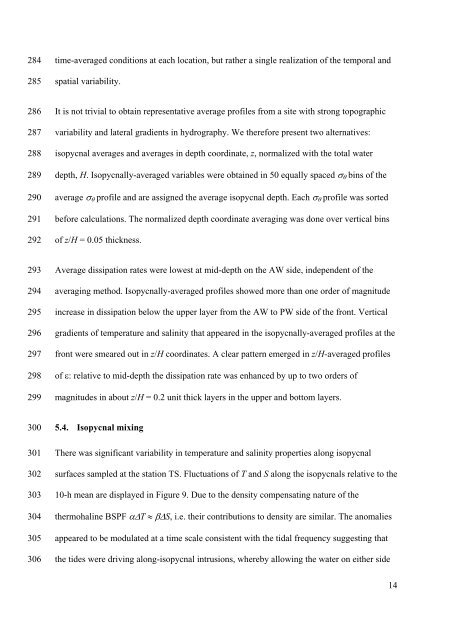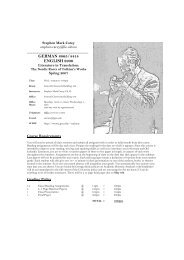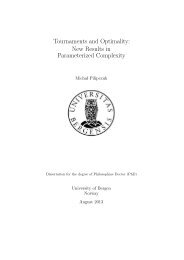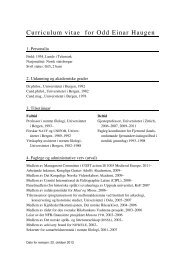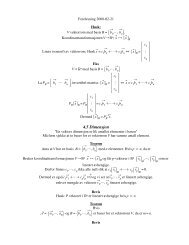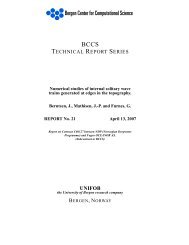Mixing in the Barents Sea Polar Front near Hopen in spring
Mixing in the Barents Sea Polar Front near Hopen in spring
Mixing in the Barents Sea Polar Front near Hopen in spring
Create successful ePaper yourself
Turn your PDF publications into a flip-book with our unique Google optimized e-Paper software.
284<br />
285<br />
time-averaged conditions at each location, but ra<strong>the</strong>r a s<strong>in</strong>gle realization of <strong>the</strong> temporal and<br />
spatial variability.<br />
286<br />
287<br />
288<br />
289<br />
290<br />
291<br />
292<br />
It is not trivial to obta<strong>in</strong> representative average profiles from a site with strong topographic<br />
variability and lateral gradients <strong>in</strong> hydrography. We <strong>the</strong>refore present two alternatives:<br />
isopycnal averages and averages <strong>in</strong> depth coord<strong>in</strong>ate, z, normalized with <strong>the</strong> total water<br />
depth, H. Isopycnally-averaged variables were obta<strong>in</strong>ed <strong>in</strong> 50 equally spaced b<strong>in</strong>s of <strong>the</strong><br />
average profile and are assigned <strong>the</strong> average isopycnal depth. Each profile was sorted<br />
before calculations. The normalized depth coord<strong>in</strong>ate averag<strong>in</strong>g was done over vertical b<strong>in</strong>s<br />
of z/H = 0.05 thickness.<br />
293<br />
294<br />
295<br />
296<br />
297<br />
298<br />
299<br />
Average dissipation rates were lowest at mid-depth on <strong>the</strong> AW side, <strong>in</strong>dependent of <strong>the</strong><br />
averag<strong>in</strong>g method. Isopycnally-averaged profiles showed more than one order of magnitude<br />
<strong>in</strong>crease <strong>in</strong> dissipation below <strong>the</strong> upper layer from <strong>the</strong> AW to PW side of <strong>the</strong> front. Vertical<br />
gradients of temperature and sal<strong>in</strong>ity that appeared <strong>in</strong> <strong>the</strong> isopycnally-averaged profiles at <strong>the</strong><br />
front were smeared out <strong>in</strong> z/H coord<strong>in</strong>ates. A clear pattern emerged <strong>in</strong> z/H-averaged profiles<br />
of : relative to mid-depth <strong>the</strong> dissipation rate was enhanced by up to two orders of<br />
magnitudes <strong>in</strong> about z/H = 0.2 unit thick layers <strong>in</strong> <strong>the</strong> upper and bottom layers.<br />
300<br />
301<br />
302<br />
303<br />
304<br />
305<br />
306<br />
5.4. Isopycnal mix<strong>in</strong>g<br />
There was significant variability <strong>in</strong> temperature and sal<strong>in</strong>ity properties along isopycnal<br />
surfaces sampled at <strong>the</strong> station TS. Fluctuations of T and S along <strong>the</strong> isopycnals relative to <strong>the</strong><br />
10-h mean are displayed <strong>in</strong> Figure 9. Due to <strong>the</strong> density compensat<strong>in</strong>g nature of <strong>the</strong><br />
<strong>the</strong>rmohal<strong>in</strong>e BSPF T S, i.e. <strong>the</strong>ir contributions to density are similar. The anomalies<br />
appeared to be modulated at a time scale consistent with <strong>the</strong> tidal frequency suggest<strong>in</strong>g that<br />
<strong>the</strong> tides were driv<strong>in</strong>g along-isopycnal <strong>in</strong>trusions, whereby allow<strong>in</strong>g <strong>the</strong> water on ei<strong>the</strong>r side<br />
14


